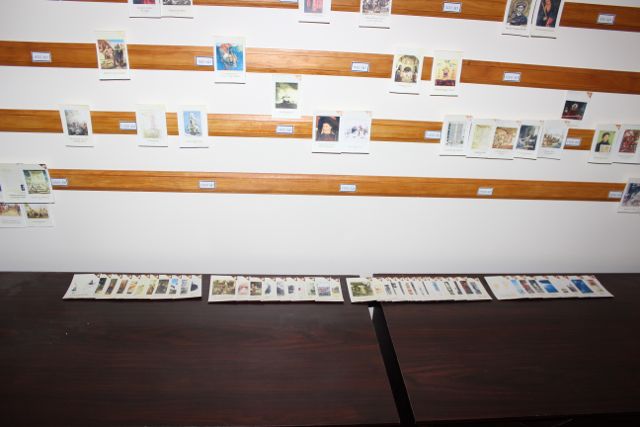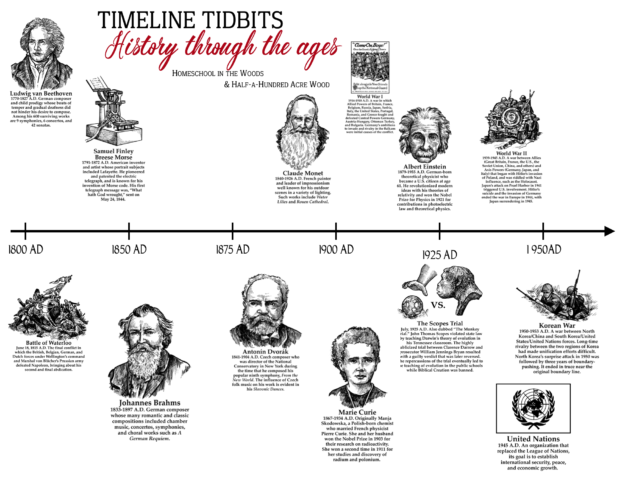
We bid farewell to our timeline wall this past weekend. We had to take it down to make room for something we’ve been patiently awaiting for the past decade…

…custom-built bookshelves!
But if you’ve ever wanted to see what a timeline (such as Veritas Press or Classical Conversations) looks like when it’s posted on a linear time scale, here it is again:
If you notice, there’s a section where the timeline cards are missing. That’s from c. 1750-2000. Here’s a close-up of that section:

We couldn’t fit the cards up there and actually see them….

because they were stacked on top of each other.

This is why our family would recommend a non-linear timeline if you decide to create a timeline wall or a timeline notebook (also known as a Book of Centuries). If you decide to also include U.S. Presidents and other events on the timeline, it’s best to have 10-year intervals for the years 1750 to present. This was a personal lesson learned by one of my favorite most frequently used learning methods: trial-and-error!

Our Timeline Notebook
I wanted to quickly share a comparison of our timeline wall to our timeline notebook, which was NOT linear. First, our timeline notebook looks like this, folded up inside a 2-inch notebook.

We used the expanded version, and, yes, I taped about a hundred pages together (in about 10-page increments) so that we could see large spans of time in a single glance. After having made a previous Book of Centuries without accordion-style pages, our upfront time investment was worth it to us. [Click here to download your own copy of these notebook pages.]
This [expanded] notebook is set up as follows:
- 100-year intervals to 200BC,
- then 50-year intervals to 1500 AD,
- then 25-year intervals to 1700 AD,
- then 10-year intervals to 2010 AD.
[The download for the expanded version does not have specific labels indicating that the timeline intervals are changing, but the condensed timeline printable I made (specifically for those wanting to print fewer pages) includes some extra years labeled around each transition.] For more about the Timeline Notebook, please visit this post.
By the way, if you download these, you need not tape them together – you can use them as a regular Book of Centuries, which means you print them out, hole-punch them, and stick them in a notebook. If you’re using a Classical Notebook, this may not fit into it along with the other subjects (unless you use a 3 or 4 inch binder). We keep our timeline separate from the rest of our Classical Notebook.
At 100-interval spacing, this is how our timeline notebook starts. It looks a lot like our timeline wall did – lots of empty space in the beginning (which is also why I created a condensed version of the notebook pages).

When we started out [above], we were using some small images of timeline cards we were using at the time. [I no longer have this file.]
For the final 3 centuries, I increased the time to 10-year intervals. Below is a photo that includes ONLY the timeline card images for Classical Conversations. And it does not include the U.S. Presidents, nor does it contain images or drawings from all of our other history studies! It will be very full by the time we incorporate our other figures. {By the way, you need not purchase timeline figures – your children can simply write the people/events into the notebook and/or draw a figure for that person/event.}

So, there you have it! I’m hoping this will help someone else out there to see the big picture before getting started! You can visit the following posts about timelines for links to free timeline resources, printable notebook pages and timeline wall templates/labels, and more information about [and photos of] the various ways we’ve recorded our timeline.
Keeping a Timeline
An Accordion Timeline Notebook
History through the Ages timeline notebook (favorite!)
As far as our timeline wall goes, I’m not sure what we’re going to do for that now because our log home lacks the wall space for such things! [This would be the advantage to having a notebook that will fit on a shelf. And NOW we have a shelf to put it on!]
You may also want to check out our latest timeline notebook! It’s our most favorite of all! 🙂


